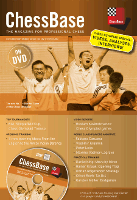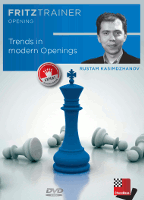Wow! Just Wow!
Review by Brian Almeida
ChessBase Magazine #162, Rainer Knaak (ed.), ChessBase 2014, DVD and printed booklet, Figurine Algebraic Notation, 26pp. $23.95 (ChessCafe Price $17.96)
ChessBase Magazine is the multimedia publication from ChessBase that mixes videos, annotated games, training, and entertainment. It is published every two months and supplemented with the bi-monthly ChessBase Magazine Extra on alternating months. The centerpiece of Issue #162 is the Tromso Chess Olympiad, with annotations by many of the participating players, and videos by Daniel King and Rustam Kasimdzhanov, along with several hours of ChessBase TV videos featuring interviews with players, trainers, and personalities. There is coverage of the Sinquefield Cup in Saint Louis and the Hans Suri Memorial tournament in Biel, among other events. The printed booklet also includes an interview with Komodo 8 developers Mark Lefler and Larry Kaufman.
With regard to the Olympiad, the editorial introduction by Rainer Knaak speculates about why Russia has scored so poorly in recent outings, even though they were still the number one seed in Tromso and enjoyed a large lead in ratings. He explores various explanations and designates the game Navara-Grischuk as a brilliancy annotated in detail on the DVD by Igor Stohl. In fact, it is so heavily annotated that to print out this one game would take at least nine pages.

China won the gold medal and the jubilant Chinese team adorns the cover of this issue. The Tromso database has 3,772 games, a three-part opening survey by Mihail Marin, and a tournament report. Other content includes all eleven of Daniel King’s “Game of the Day” videos for each round, Rustam Kasimdzhanov’s videos of his wins against Kramnik and Naiditsch, and thirteen ChessBase TV videos, featuring Alexei Shirov, Garry Kasparov, Wesley So, Vladimir Kramnik, Tanya Sachdev and others.
Players who annotated their games include Bartel, Edouard, Eljanov, Fier, Illingworth, Kramnik, Laznicka, Mekhitarian, Negi, Postny, Sasikiran, Sutovsky, and Yu Yangyi. Other commentary was provided by Ftacnik, Krasenkow, Marin, Marjanovic, Meulders, Roiz, Stohl, Sumets, and Szabo.
The Sinquefield Cup in Saint Louis was billed as “the strongest tournament in the history of chess,” with six of the top nine players in the world competing. Along the way to winning the Category 23 event and $100,000 top prize, Fabiano Caruana won seven consecutive victories to finish on 8.5 out of 10, with an Elo performance of 3107. The DVD offers annotations and analysis by Havasi, Krasenkow, Postny, Roiz, Sagar Shah, and Szabo.
Maxime Vachier-Lagrave was the winner of the Hans Suri Memorial Biel with 6 out of 10. He annotated his game against Motylev, while Daniel King provides his ten daily video summaries. Other comments are contributed by Krasenkow, Sagar Shah, Sumets, and Szabo.
Other tournaments include the 42nd Dortmund GM, also won by Fabiano Caruana, who annotated his game against Ponomariov. Szabo and Havasi have also annotated two of Caruana’s other games. Peter Leko comments on his game against Naiditsch and Georg Meier analyzes his win over Kramnik. Wesley So won the ACP Golden Classic in Bergamo and provided notes for his game against Vocaturo, Emil Sutovsky contributes two of his own games. In Plovdiv, Valentina Gunina won the European Women’s Championship and annotates a game, as does the runner-up Tatiana Kosintseva, with other games annotated by Adrian Mikhalchishin. Furthermore, there is content from the French Championship, won by Laurent Fressinet, and the Politiken Cup. All told there are more than eighty annotated games in this issue.
And that’s not all! There are three opening videos:
Ftacnik on the Anti-Grünfeld Defense: 1.d4 Nf6 2.c4 g6 3.f3
The Anti-Grünfeld 3.f3 occurred eleven times at the Chess Olympiad and scored eight points. Lubomir Ftacnik gives you an extensive overview in which the secondary moves are just as accurately examined as the main variation 3…d5.

Shirov on the Reti Opening: 1.Nf3 d5 2.g3 Bg4 3.Bg2 Nd7
According to Alexei Shirov, opening theory is developing in two directions. On the one hand, there are long theoretical variations that are being analyzed to near perfection with computers, and anyone who is unprepared crashes over the board. On the other hand, there are games where theory is avoided as soon as possible. In the first video clip an original and sharp position is rapidly reached and after Shirov’s rook sacrifice it soon leads to an unusual distribution of material. In the second game things develop more calmly, where knowledge of plans is more important than that of variations.
Marin on the Bird Opening: 1.b3 Nf6 2.Bb2 e6 3.e3 b6 4.f4 Bb7 5.Nf3 Be7 6.Bd3 c5 7.0-0
In the game Ni Hua-Teh, White aimed his forces towards the black kingside and obtained a clear advantage to win the game.
And eleven opening articles:
Stohl: English Flohr-Mikenas Variation
As Igor Stohl demonstrates, the Mikenas-Flohr Variation of the English Defense is really reliable from Black’s point of view, but at first there is a struggle for equality. Even Aronian came to grief when he played the variation with black against Grischuk.

Rotstein: Old Indian 2.c4 d6 3.Nc3 Bf5 4.Nf3 c6
According to Arkadij Rotstein’s analysis White cannot lay claim to a simple advantage after 4.Nf3 c6. Above all, 5.Nh4 Bg6!? proves to be surprisingly playable for Black.
Antic: Benoni Fianchetto Variation 11.Bf4
The white bishop move is somewhat annoying for Black, since the natural developing move 11…Nbd7 is now excluded. Dejan Antic analyzes the two popular replies 11…h6 and 11…Nh5, but believes that only the latter offers certain chances for equality.
Havasi: Modern Defense 4.f4 a6 5.Nf3
Gergo Havasi investigates 5…Nd7, and has reserved the main variation 5…b5 for his next article. White should achieve a comfortable game with natural developing moves – developing the bishops.
Krasenkow: Closed Sicilian
Michal Krasenkow thinks that the Closed Sicilian is very playable at amateur level. In his article he presents a repertoire for White, one that he used himself until he reached a playing strength of around 2400.
Postny: Sicilian Paulsen 6.Nxc6
The variation attracted the attention of Evgeny Postny because it was recently played by Fabiano Caruana – both with white and with black. There is a trend away from 11…g6 to 11…Kf8. At the moment the variation appears to be under development and there are as yet no certainties.
Szabo: Sicilian English Attack
The continuations 12…Bg7 and 12…Qc7 are up for discussion. Krisztian Szabo shows that beyond knowledge of variations one should also master a few tricks and maneuvers.

Müller: King’s Gambit à la Quaade, Part 1
In the first part of his repertoire for White with the King’s Gambit Karsten Müller acquaints you the Quaade Gambit: a setup with Nc3, d4, and g3. It works excellently against Fischer’s Defense 3…d6 and Becker’s Defense 3…h6.
Breder: Ruy Lopez Four Knights 4…Nd4
The article by Dennis Breder focuses, after 4…Nd4, on the reply 5.Ba4. It should be followed by 5…c6 and in many lines Black can even hope for more than mere equality.
Kuzmin: Queen’s Pawn Game 2.Nc3 Nf6 3.Bf4
Alexey Kuzmin utilizes the games of Baadur Jobava, who has recently been employing this variation successfully. Jobava’s special variation comes after the most played move 3…Bf5 in the form of 4.f3 e6 5.g4 Bg6 6.h4.
Marin: Nimzo-Indian 4.e3
The line with …c5 is very solid and involves a substantial amount of theory, but Mihail Marin shows how White can set his opponent problems and aim for an advantage starting with 8.Na4.
And there is still more! Including the following regular columns:
Daniel King: Move by Move
Daniel King has chosen the Queen’s Gambit game Kasimdzhanov-Kramnik, Tromso 2014. It is in interactive video format so you have the chance to find the correct moves.
Rogozenco: The Classic
In his classic video Dorian Rogozenco demonstrates the game Rubinstein-Salwe, Lodz 1908.

Reeh: Tactics: “Model attacks against the castled king”
Oliver Reeh’s article contains thirty-two games from Tromso, studded with training questions and with an introductory text and a video in interactive format. It was a little disconcerting to have the board change perspective with each move, as the program by default displays the view from the side to move. Yet there is a radio button that allows you to change this behavior. I would prefer the default to have the board stationary and not twisting up and down with every move.
Müller: Endgames: “Passed pawns must advance”
Karsten Müller’s column contains two introductory texts, twenty-seven annotated endgames, many training questions and four video clips. Additionally, he has recorded two endgames in interactive format.
Rogozenco: Strategy: “Good bishop, bad bishop”
Grandmaster Dorian Rogozenco deals with good and bad bishops. He explains the basics in a video and after that training questions are posed to the viewer.
Knaak: The Opening Trap
Rainer Knaak’s column contains five traps from Tromso, including a Fritztrainer video.

There is also a section with samples of seven new products with videos of the DVDs by Bologan, Ramirez, Negi, Marin, Martin, and Müller and Meyer.
There can only be one reaction to all this content. Wow! Just Wow! The trouble is finding the time to get through it all. It would be nice if the content were accessible via the ChessBase App on the iPhone or iPad, because then the user would have a greater number of viewing options. I am more likely to just select one or two particular issues per year for purchase rather than subscribe to every issue, which I know I could never keep up with. Nevertheless, ChessBase Magazine is an extraordinary product. To utilize the content to its fullest you need the latest update of the freely available ChessBase Reader, or ChessBase 12 or 13, or Fritz 13 or 14.
My assessment of this product:
![]()
Order ChessBase Magazine #162
by Rainer Knaak (ed.)
A PDF file of this week’s review, along with all previous reviews, is available in the ChessCafe.com Archives.
© 2014 ChessEdu.org. All Rights Reserved.




It’s unfortunate that Chessbase Magazine is not available as a download, as the shipping cost is prohibitive for many prospective purchasers.